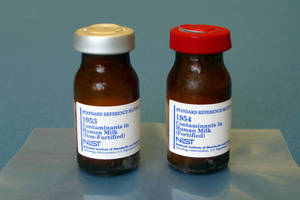NIST issues reference materials for milk/blood contaminants.
Share:

Press Release Summary:

NIST has released 4 Standard Reference Materials (SRMs) in response to scientists' need to measure organic contaminants in human body fluids. They will be used as controls in experiments and reflect increase in levels of brominated flame retardants and chemicals found in carpeting/upholstery since 2000. All were packaged half unfortified and half fortified with 172 contaminants at levels 5-10x median concentrations in U.S. population. Milk SRMs contain similar contaminants as serum materials.
Original Press Release:
NIST Issues Human Milk and Blood Serum SRMs for Contaminant Measurements
Responding to scientists' need to measure organic contaminants in human body fluids, the National Institute of Standards and Technology (NIST) has recently made four new Standard Reference Materials (SRMs) available for purchase. Developed in collaboration with the Centers for Disease Control and Prevention (CDC), the human milk and serum SRMs have certified levels of contaminants, including flame retardants and pesticides, commonly found in the U.S. population. Scientists at the CDC and other laboratories will use the SRMs as controls in their experiments to ensure their methods are providing trustworthy results.
NIST first released its first serum-based SRM (SRM 1589 Polychlorinated Biphenyls in Human Serum) in 1985 to aid with the detection of polychlorinated biphenyls (PCBs), a toxic mixture of compounds used in transformer oils that was banned in the U.S. in the 1970s. Since NIST researchers last updated the SRM in 2000, the levels of PCBs, pesticides, dioxins/furans and other contaminants have decreased by 50 percent while the levels of brominated flame retardants, chemicals found in carpeting and upholstery, have been on the rise. NIST researchers created the new SRMs to reflect these changes.
The first of their kind, the milk SRMs contain similar contaminants as the serum materials.
To prepare these SRMs, scientists collected 200 liters of blood serum and 100 liters of milk from banks across the United States and divided the sample pools in half. (Note that the milk that was used to prepare the SRM was not suitable for feeding babies because the donors may have taken medications such as acetaminophen or the milk had reached its expiration date.) Researchers packaged half of each material as received, containing the natural (unfortified) level of contaminants, and treated (fortified) the other halves with a solution containing 172 selected contaminants. The fortified samples contain a concentration of those contaminants at levels five to 10 times higher than the median concentrations found in the U.S. population.
NIST SRMs have been rigorously tested and certified as having specific properties that researchers can trust as accurate within stated levels of uncertainty. The values stated on the certificates for these SRMs were measured by NIST and the CDC using a number of different methods including gas and liquid chromatography with mass spectrometry detection.
For more information, see:
SRM 1953 Organic Contaminants in Nonfortified Human Milk s.nist.gov/srmors/view_detail.cfm?srm=1953
SRM 1954 Organic Contaminants in Fortified Human Milk s.nist.gov/srmors/view_detail.cfm?srm=1954
SRM 1957 Organic Contaminants in Nonfortified Human Serum s.nist.gov/srmors/view_detail.cfm?srm=1957
SRM 1958 Organic Contaminants in Fortified Human Serum https://s.nist.gov/srmors/view_detail.cfm?srm=1958
Contact NIST Technology Services at (301) 975-2200.
Media contact: Mark Esser, mark.esser@nist.gov, (301) 975-8735




